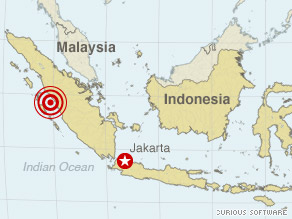
A major earthquake that struck Indonesia Wednesday killed at least 21 people and injured hundreds more, an official said.
Thousands may be trapped by collapsed buildings and houses, said Rustam Pakaya, the head of Ministry of Health’s crisis center.
He said 75 people were heavily injured.
The quake caused widespread power and phone outages, making it difficult to assess the scope of the damage.
It struck at around 5 p.m. local time, about 33 miles (53 kilometers) from Padang, the capital city of West Sumatra. Padang is home to more than 800,000 people.
State-run Antara news agency said the earthquake “killed tens of people and destroyed hundreds of buildings including houses, shopping centers and mosques,” though that report did not cite its sources.
The U.S Geological Survey said the earthquake had a magnitude of 7.6.
The earthquake was felt in nearby cities, such as Medan and Gengkulu, where people panicked and ran outside in search of higher ground, fearing a tsunami.
But it was also felt as far away as Singapore and Malaysia.
“I did feel the tremor in office today somewhere between 5 to 6 p.m.,” said Ratna Osman, who works in a single-story office building in Petaling Jaya, just outside Malaysia’s capital, Kuala Lumpur.
“I asked [a co-worker] if there’s an earthquake somewhere — either that or I was hallucinating.”
“At first, I thought the chair I was sitting on had a screw loose or something,” Osman said.
The region is accustomed to earthquakes, and locals have been taught to identify safe places in case of a tsunami, according to Sean Granville-Ross, the Mercy Corps country director for Indonesia. “We hope that preparation is now paying off,” he said.
But if many homes have been destroyed, people may be spending the night with no shelter, he said.
World Vision Indonesia’s Humanitarian and Emergency Affairs director, Jimmy Nadapdap, said in a written statement that the organization would try to fly assessment teams to the quake zone Thursday morning.
“It is critical that we get people into the quake zone as soon as possible to find out what has happened,” he said.
“If buildings have collapsed then people are likely to be in urgent need of food, water and especially shelter. The injured will also need medical assistance,” he added.
“What typically happens is that people become terrified to go back into their homes.”
Phone lines were apparently down in many parts of Padang. Indonesia’s Tempo Interactive, a media outlet based in Jakarta, had trouble reaching its correspondent in the West Sumatra city, according to journalist Purwani Diyah Prabandari.
“I hope it’s just the cell phone connection,” Prabandari said
Indonesians trying to find out more about the Sumatra quake flooded the Internet, including Twitter. Some expressed concern for relatives and friends in Padang.
“Dear God, please send down your angels to hug and protect my grandpa in Padang,” said one Twitter post.
The Web site for one of Indonesia’s main newspapers, The Jakarta Globe, crashed for a while, partly as a result of the heavy traffic from people trying to find out about the quake, the paper said in a Twitter post.
The Pacific Tsunami Warning Center of the National Oceanic and Atmospheric Administration issued a tsunami watch for Indonesia, India, Thailand and Malaysia, but canceled it soon after.
The temblor did generate a tsunami just under one foot high, the Pacific Tsunami Warning Center said.
On Tuesday, a magnitude 8.0 quake-triggered tsunami killed at least 111 people in the Samoan islands and Tonga. Read latest news on the Samoa quake and tsunami
The tsunami waves swept across a wide swath of the Pacific Ocean, killing dozens and flattening or submerging villages.
Officials warned that the death toll could rise as rescue workers start to reach outlying villages and discover new casualties.
The U.S. Geological Survey declined to say whether the two quakes were linked. “The simple answer is we can’t speculate on a connection,” Carrieann Bedwell of the USGS said. “Both are in highly seismic areas.”
The epicenters of the two temblors are about 4,700 miles (7,600 kilometers) apart.